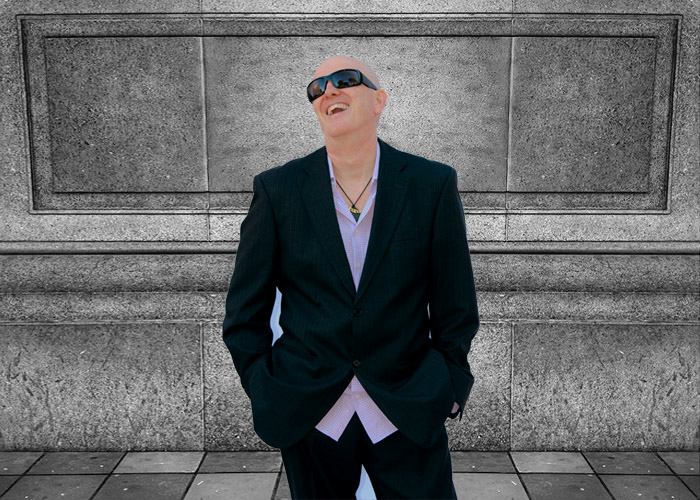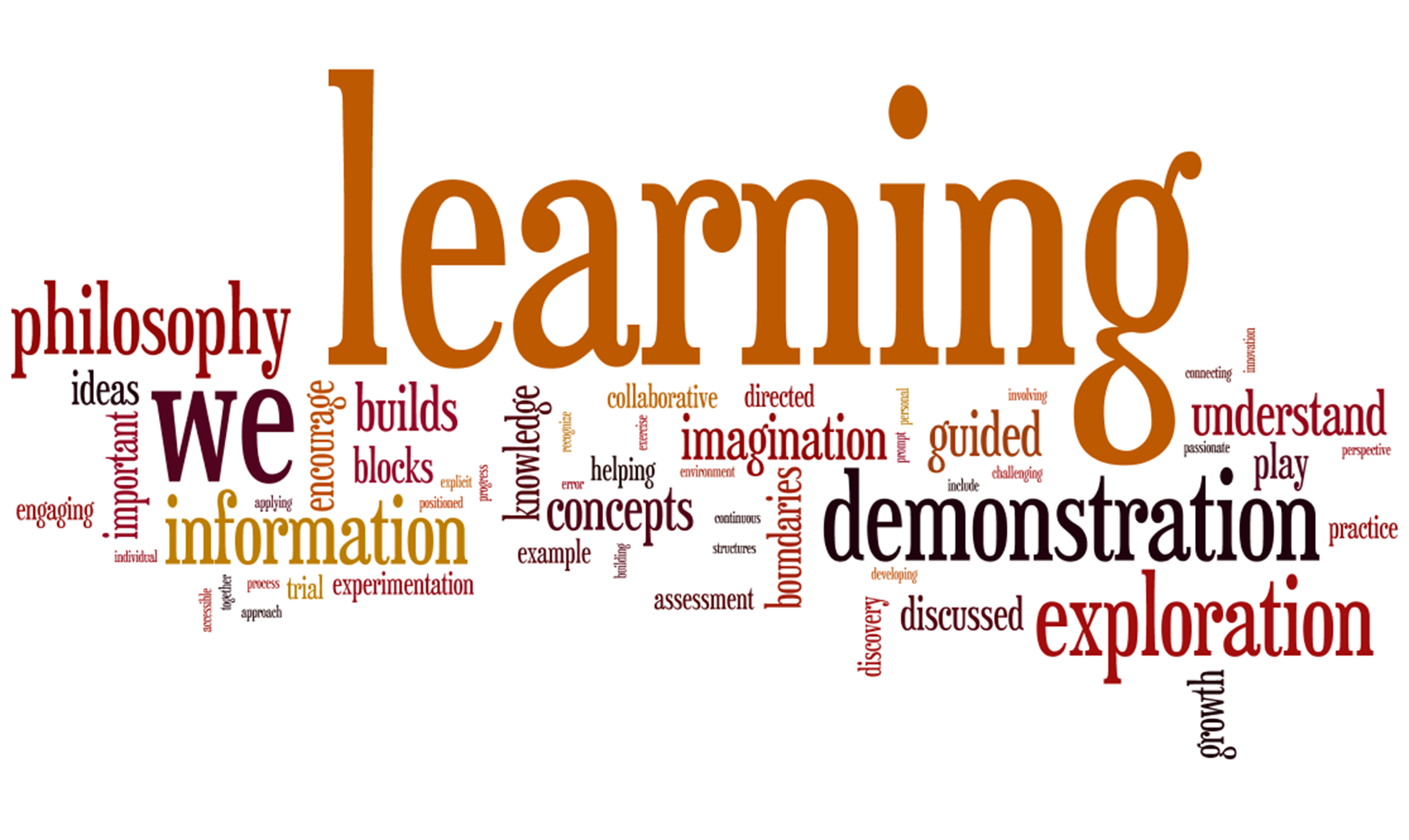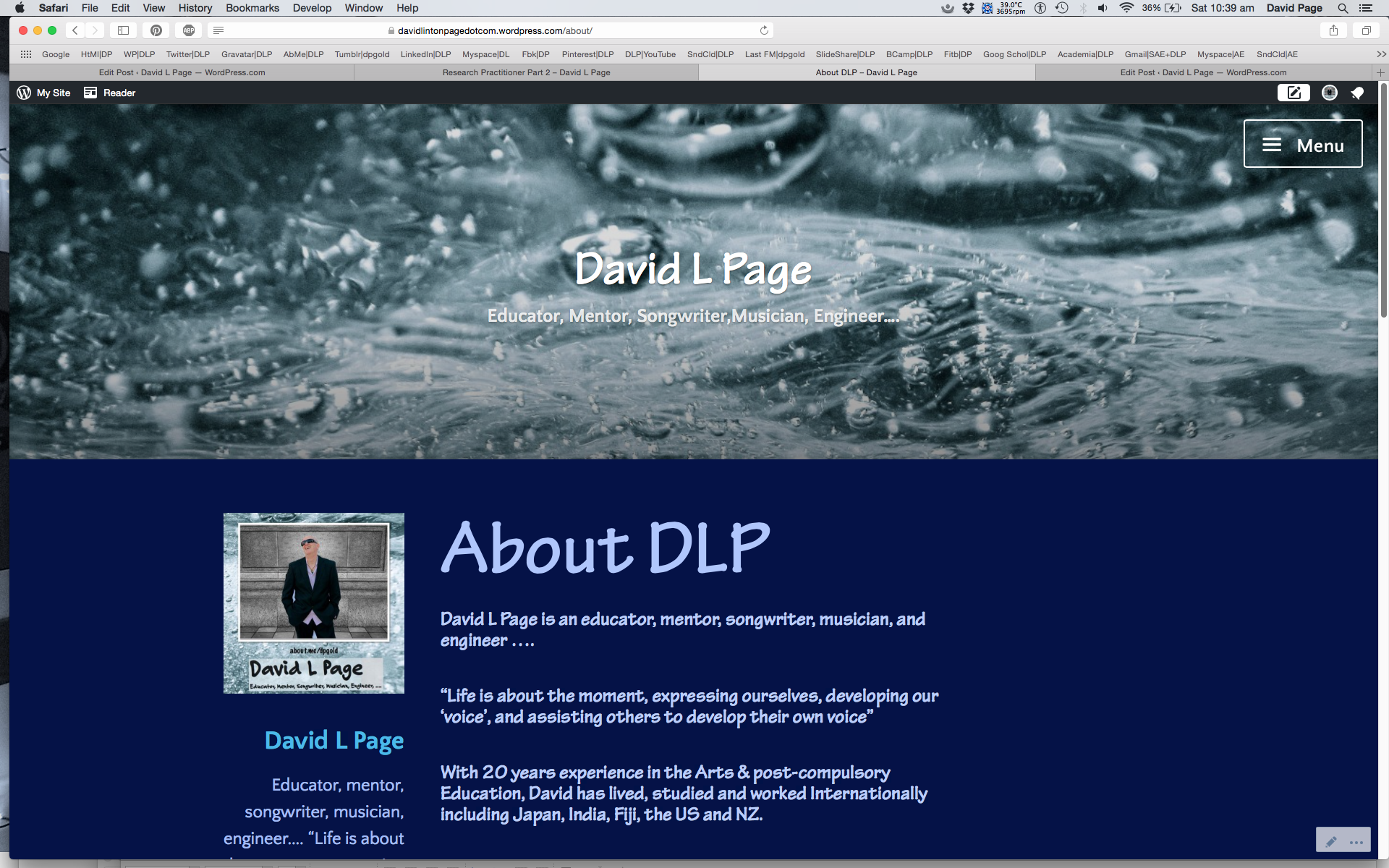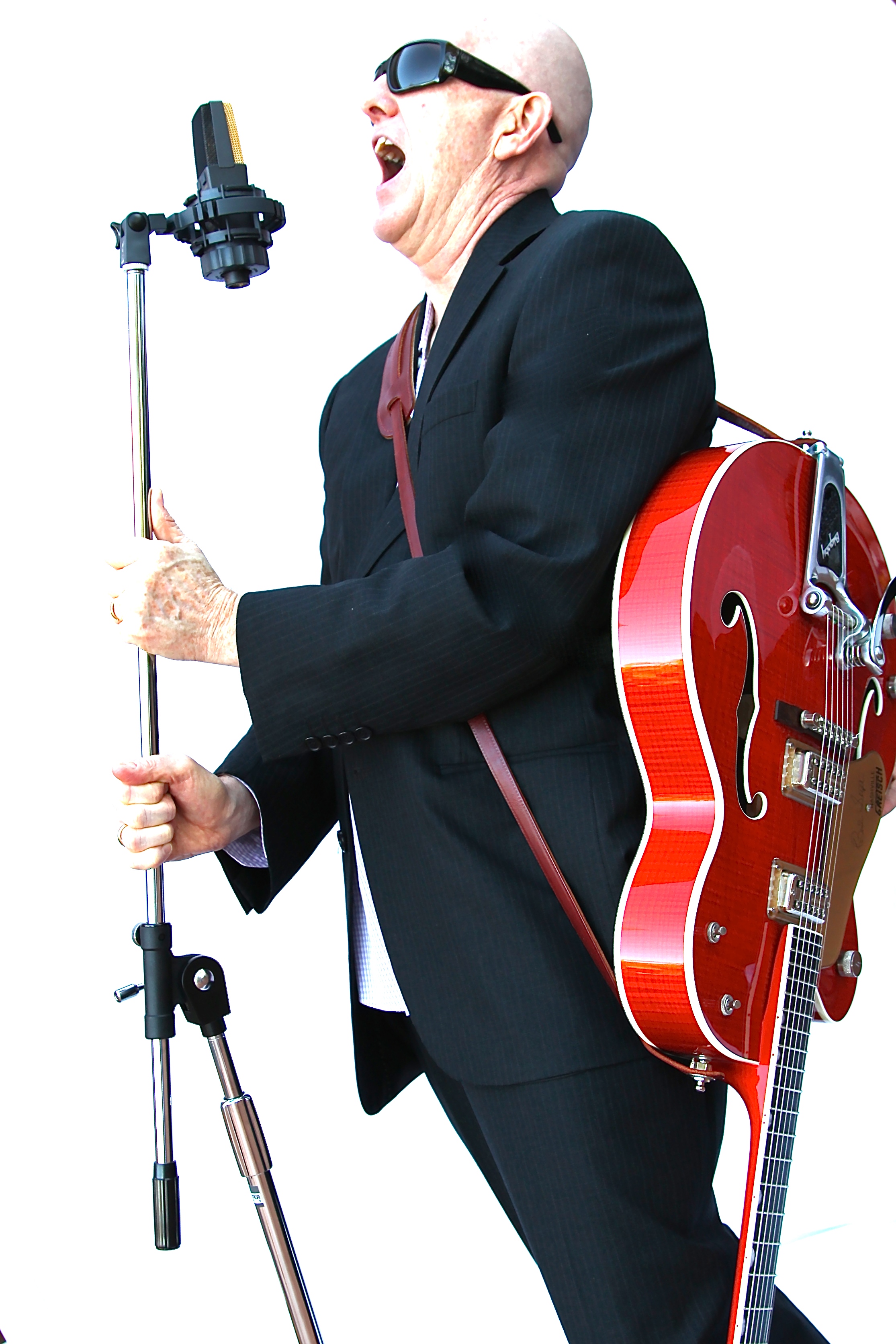A year to remember….

(Page 2014a)
This blog is a continuation of a series. See here (Page 2014b) for the previous blog.
My life – music-making and education & learning
My journey in music-making commenced a number of decades ago. I made music via physical instruments. I strummed chords on a guitar or piano, hummed or played a melodic phrase, developed lyrics, and over time a song emerged. I felt connected to the music. I recall getting positive feedback when I shared my acoustic instrument-based songs with an audience. I followed this approach several hundred times over several decades, and because of the relative ease these songs came to me, I never had felt a need to consciously consider my music-making process.

(Page 2014c)
As technologies developed, I transitioned into music-making using digital virtual technologies. I invested in virtual technologies, trialling a number of virtual music-making applications – digital audio workstations (DAWs). I experimented; I spoke to local pro audio retailers; I experimented some more; I bought instructional books and videos; I studied; I experimented a lot more. Over a number of years however, I found that irrespective of how much time and money I invested into my virtual music-making production practice, I never managed to achieve a similar flow or a similar feeling – a creative high – as I had music-making using physical instruments. My frustration grew using virtual technologies to make music. I enrolled into a practical tertiary course. The course assisted me greatly to develop my theory and practical skills. However, using virtual technologies to make music that I felt connected to, (largely) continued to elude me. There was one instance, a remix project where I felt a connection. That experience gave me hope that my attempts to use virtual technologies to make music I felt connected to, was not going to be in vain. I continued to experiment; I continued to read; I continued to invest; I continue to immerse my self into my virtual music-making production practice. However, I still found I wasn’t achieving a similar flow or a similar feeling – a creative high – using virtual technologies to make music as I had music-making using physical instruments. My frustration was at an all-time high. I had arrived at a juncture in my life where I felt there was now no alternative: my virtual music-making production practice needed an intervention. I needed to put my creative practice using virtual technologies to make music, under scrutiny.
(Page 2014d)
In 2013 I applied to a formal academic research program – a professional doctorate program. I was accepted in readiness for commencing in 2014. However, as I neared the 2014 commencement date I accepted my very busy education and training role was not going to be conducive to embarking on such a demanding journey as a doctoral research study, at that time. I therefore immediately applied for a delayed commencement to 2015.

With my delayed commencement formalised, it allowed me to reconsider – to delve down into the many ideas I had for a higher degree research study topic. I developed mindmaps for each of the nineteen (19) potential topic ideas I had, drilling down to see where they took me. I was looking for a topic that allowed me to research as many aspects of interest.
In 2013/2014 I was practicing creatively, while also lecturing in creative media across the range of audio production modules – audio theory, signal flow, microphones, processing – , and a cross-disciplinary creative media studies module. SAE Institute has been going through exponential development – strategically and structurally. With a radical change to the focus of their academic programs, new academic staff were being recruited to lead the re-writing of the academic programs. SAE Institute revised focus was now to be project-based learning, promoting learners to engage to more in the learning process, developing assessment tasks that met their interests while realising the required learning outcomes. A major benefit of this approach was the possibility of cross-disciplinary collaborations. As part of the revised focus, all undergraduate programs were now to include studies in the broad discipline of creative media studies and critical thinking. As a Senior Lecturer with broad experience across a number of disciplines, I was assigned to assist on one of the new cross-disciplinary creative media studies module. Late last year the new versions of the undergraduate programs were rolled out.

However, despite many decades of post-compulsory education experience, I found in talking to the newly recruited academics a lot of their language that largely went over my head. These new peers were recruited from within the Australian higher education (HE) institutional system. Following completion of their doctorates, most had taught in the specialised HE environment, whilst continuing with their research projects and publishing schedule.
As part of the creative media studies stream at our Institute, learners were now to be immersed in specific creative media lexis and theory, via tasks that guided the aspiring practitioners in the development of them selves as unique and individual creative media identities. They were to learn to critically consider what creative media is for them as practitioners; researching and investigating concepts and areas of the creative media industry they may possibly choose to engage in via their practice. They were to then apply these concepts to develop their unique creative media practice. With a developed sense of themselves, having time to form their world views, they would be guided in their development as aspiring professional practitioners; and as undergraduate academic researchers.

(Page 2014e)
My background, and therefore my approach, was so different. I had developed my multiple forms of practice throughout my life, fundamentally as a craftsperson. I was practical. I liked to be hands-on. I had learnt to become a successful practitioner via the 10,000 hour rule – practice, consider, practice, reconsider, practice, etc. I had a Masters level of education, but I didn’t ever consider my self as a higher education critical thinker. I was a practical person that looked at outcomes. This is what I did for organisations over a number of decades – I improved outcomes. I was analytical for a functional outcome. My brief entrée in an education doctorate program in 1999 reinforced this. I accepted I was not naturally inclined as a scholar. I was a functional, practical practitioner.
When the newly recruited academics began arriving at SAE Institute late last year, speaking a language that largely went over my head, I felt very out of place. By the beginning of this year, I felt very challenged. Challenged on every front: as an educational practitioner, despite my years of experience, knowledge and developed skills; as a music practitioner – again, despite my years of diverse experience, knowledge and developed skills; as a guide and mentor to my learners. A question I asked my self was: how could I guide others when I was struggling with my own learning? I was struggling to both understand and engage in all forms of technology and networking opportunities currently on offer via the internet that were now part of the Institute’s degree program. I recall questioning my place within the higher education environment; I recall questioning my place within the Institute; in fact, I even recall questioning my place within an organisational workplace.
I have never considered my self smart, but had the experience of knowing what had served me well for most of my life: the principle of 10,000 hours (Page 2004). I decided to engage developing this new knowledge and approaches to contemporary creative media practice in the only way I knew how: hours of research, and hours of trial and error. My motive to engage in this were: I knew I needed to learn in order to model to my learners what their assessment tasks were asking of them; I needed to learn in order to be able to guide my learners as to how to do such tasks effectively and efficiently; I needed to learn in order to model the importance of these approaches in order for them to develop an industry ready practice by the end of their degrees; I needed to learn in order to engage with my new peers – the recently recruited academics; I knew I needed to learn in order to embrace new ways of seeing my practice – to see my creative practice through a different set of eyes. After all, my eyes had only gotten me so far in my creative media career. I was also reminded that my entire point of my engaging in my intended higher degree research was to discover what I had not been able to discover within my own means. Whilst this process was not yet part of my doctoral research study, I recall seeing the situation I found my self in as an opportunity to learn and develop under the tutorage of several published creative media academics. In addition to understanding the value of hard work, I also understood that I had always been an opportunist. I decided to embrace this opportunity of these new found peers, irrespective of whether I could immediately see the point or benefit of how such new knowledge or approach was going to apply to my creative practice. Frankly, I couldn’t. My head chatter throughout the year has been at a critical level. Internally, almost on a daily basis, I have been debating the pros and cons of such knowledge or approach, particularly in regards to the internet-based technology and networking opportunities.
Below is a small sample list of journal entries I have written in 2014. These journal entries record my newly acquired knowledge and approach to my music-making practice. These have been written for my eyes only, in order to record my learning, and to frame my position with regard to these topics as a practitioner; particularly for my role as an education and learning practitioner in a creative media higher education institution. You will note: some of the journal entries are more technical in nature – for example, the first four (4) Critical listening journals; some are about developing how, as a practitioner, I interact with society – for example the Media Identity and Curation journal; whilst others are about reflecting on my autobiography, and starting to consider who I was as a music practitioner – for example Beginnings, Life is About the Moment, What Brought Me Here and Genealogy. I concluded this year with the journal entry Reflecting Part 1 (as described in Doctoral Research Study Part 1 (Page 2014b), reflecting upon my life up until now. I was about to embark up a new journey in academia, and needed now to ground my self, and begin to focus on the journey in front of me.
(Page 2017a)
I believe going through this intensive one plus year long process was worthwhile in my development as an education and learning practitioner, in the specific discipline of creative practice. As I acquired this new knowledge, I found I now:
· felt more broadly informed when I taught related topics at this Institute; and
· more informed and better able to engage with learners in a range of discussions that I had been able to previously;
· more equipped to respond quickly to their many questions, irrespective of which discipline they were engaged in;
· whilst I was not of the belief that I had yet arrived at a clear sense of my identity following this twelve (12) to fifteen (15) months worth of development, I did accept that I now had a positive view of the direction I was heading in. I had a sense that I was on the right path. I was seeking new knowledge about alternative approaches to what I had previously considered. I had a sense that my nervous excitement, looking to the horizon in front of me, was infectious, and motivating for most of the learners that I engaged with at the Institute.
(Page 2014f)
I therefore consider this experience to have been very worthwhile in my development as an education and learning practitioner, in the specific discipline of creative practice. I inherently knew that it also prepared me better for my pending studies in 2015.
Preparing for 2015
Yes, I was excited about my pending studies; nervously excited about the journey into what was largely unknown territory for me – academic research. In some ways, I likened my nervous – apprehensive – excitement to that of the character Bilbo Baggins in the Hobbit (Bros 2014): nervous about embarking on a new adventure – perhaps even somewhat resistant; but trusting I was in need of going on this adventure, for a greater good. It was for me, in many ways, a self-imposed intervention process. I know I needed to look at my creative practice through a different set of eyes. As I have mentioned: the eyes I had previously been looking through had only gotten me so far in my creative media career. I knew I needed to walk down new paths in order to discover new knowledge and approaches that I had not been able to discover within my own means in all my prior decades of practice. I was ready to apply my self to the commitment that others had led me to understand was going to be required. Of the new academic peers I had met, one had taken ten (10) years to attain their doctorate; another seven (7) years; another six (6) years; another five (5) years. I knew undertaking a three (3) full-time doctoral program, whilst working in a very demanding full-time education and learning role, was going to need focus, and lots of hours: probably 10,000 hours.

2017 Update
I commenced the doctoral program in 2015. My formal research journey had begun. On the back of the new acquired knowledge and approach in 2014, I implemented a new blog strategy at the beginning of 2015. This saw me changing my blog site from tumblr.com to wordpress.com. I did this for a number of reasons, but primarily due to:
-
wordpress.com is what we were guiding our students to create as their primary creative practice blog site;
-
functionality of the wordpress.com site, including the use-friendly nature of the interface, the editing features, and the ability to publish multi-media within the one entry.
(Page 2017b)
These journal entries were published retrospectively in wordpress.com as blog posts as soon as I opened that site. The small sample of blogs I currently have listed on my wordpres.com site under the menu category DCI Phase 0 – Starting Point (Page 2017c) – are representative of some of this new knowledge and approach I acquired and developed during this period. These journals/blogs were completed prior to my official commencement of my doctoral studies, the research study I was choosing to embark on to hopefully find answers to my long-term queries regarding my music practice: 10,000 words book-ending the beginning of my research study.

(Terry-Toons Comics 1945-1951)
This blog series is planned to continue next month with A creative artists need (Page 2015). It is intended for this blog series to continue on a regular basis as I progress through my doctoral research project.
References
Ericsson, K.A., Krampe, R.T. and Tesch-Römer, C., 1993. The role of deliberate practice in the acquisition of expert performance. Psychological review, 100(3), p.363.
Learning Philosophy image courtesy of: Learning Accessed 17th December, 2014
Onion image courtesy of: Onion Layers Accessed 17th December, 2014
Page, David L. 2017a. DLP Blog Category Topics Accessed 30th April, 2017
Page, David L. 2017b. David L Page wordpress.com site Accessed 30th April, 2017
Page, David L. 2017c. DCI Phase 0 Starting Point Accessed 30th April, 2017
Page, David L. 2015. A Creative Artist’s Need – Gratitude Accessed 30th April, 2017
Page, David L. 2014a image courtesy of David L Page Linked-In site Accessed 17th December, 2014
Page, David L. 2014b. Pre-Doctoral Research Study – Part 1 Accessed 30th April, 2017
Page, David L. 2014c image courtesy of David L Page My Space site Accessed 17th December, 2014
Page, David L. 2014d. David L Page Pinterest site Accessed 17th December, 2014
Page, David L. 2014e image courtesy of David L Page You-tube site Accessed 17th December, 2014
Page, David L. 2014f image courtesy of David L Page About.me site Accessed 17th December, 2014
Page, David 2004. Educational Philosophy Part 1 Accessed 17th December, 2014
Pulsating image courtesy of: Image Accessed 17th December, 2014
QUT image courtesy of: QUT Accessed 17th December, 2014
SAE QANTM image courtesy of: SAE QANTM Creative Media Institute Accessed 17th December, 2014
Terry-Toons Comics. 1945-1951. Mighty Mouse in Mighty Mouse #38-85 Accessed 8th March, 2014.
– @David L Page 17/12/2014
– updated @David L Page 30/04/2017
Copyright: No aspect of the content of this blog or blog site is to be reprinted or used within any practice without strict permission directly from David L Page.









